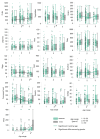Observance of the Atlantic Diet in a Healthy Population from Galicia (NW Spain): A Comparative Study Using a New Scale-Based Procedure to Assess Adherence
- PMID: 40807552
- PMCID: PMC12346738
- DOI: 10.3390/foods14152614
Observance of the Atlantic Diet in a Healthy Population from Galicia (NW Spain): A Comparative Study Using a New Scale-Based Procedure to Assess Adherence
Abstract
The Atlantic Diet (AD) is based on traditional dietary patterns in Galicia (northwestern Spain) and northern Portugal and is known for its health benefits. The AD focuses on fresh, local, and seasonal foods, especially fish, seafood, vegetables, legumes, whole grains, fruit, olive oil, and a moderate consumption of wine. However, it has received less attention from researchers than other dietary patterns. The present study had two main objectives: (i) to evaluate the dietary habits of a Galician population in relation to the AD and (ii) to create a numerical index to measure adherence to the AD. In 2022, a validated food frequency questionnaire was administered to 500 healthy adults living in Galicia. The data on participants' dietary habits showed notable deviations from the ideal AD, especially regarding consumption of fruits, grains, and seafood. However, an adequate intake of legumes and nuts was observed, along with a reduction in the consumption of processed foods (except among younger participants) relative to that revealed in previous surveys. To assess adherence to the diet, statistical and chemometric analyses were applied, leading to the development of a new index: the Atlantic Diet Scale (ADS). The ADS was compared with three existing tools and proved to be a simple, flexible, and effective method for assessing dietary adherence based on optimal intake levels across food groups. When applied to dietary data, the ADS yielded adherence levels similar to two of the three traditional methods, with some differences relative to the third. These findings highlight the need for standardized evaluation tools, including clear definitions of food groups and consistent scoring systems, to better assess and promote adherence to the Atlantic Diet.
Keywords: Atlantic Diet; Galicia (NW Spain); adherence assessment; consumption patterns.
Conflict of interest statement
The authors declare no conflicts of interest.
Figures





Similar articles
-
Prescription of Controlled Substances: Benefits and Risks.2025 Jul 6. In: StatPearls [Internet]. Treasure Island (FL): StatPearls Publishing; 2025 Jan–. 2025 Jul 6. In: StatPearls [Internet]. Treasure Island (FL): StatPearls Publishing; 2025 Jan–. PMID: 30726003 Free Books & Documents.
-
[Volume and health outcomes: evidence from systematic reviews and from evaluation of Italian hospital data].Epidemiol Prev. 2013 Mar-Jun;37(2-3 Suppl 2):1-100. Epidemiol Prev. 2013. PMID: 23851286 Italian.
-
Comparison of self-administered survey questionnaire responses collected using mobile apps versus other methods.Cochrane Database Syst Rev. 2015 Jul 27;2015(7):MR000042. doi: 10.1002/14651858.MR000042.pub2. Cochrane Database Syst Rev. 2015. PMID: 26212714 Free PMC article.
-
Systemic pharmacological treatments for chronic plaque psoriasis: a network meta-analysis.Cochrane Database Syst Rev. 2021 Apr 19;4(4):CD011535. doi: 10.1002/14651858.CD011535.pub4. Cochrane Database Syst Rev. 2021. Update in: Cochrane Database Syst Rev. 2022 May 23;5:CD011535. doi: 10.1002/14651858.CD011535.pub5. PMID: 33871055 Free PMC article. Updated.
-
The Black Book of Psychotropic Dosing and Monitoring.Psychopharmacol Bull. 2024 Jul 8;54(3):8-59. Psychopharmacol Bull. 2024. PMID: 38993656 Free PMC article. Review.
References
-
- Velho M.V., Pinheiro R., Rodrigues A.S. The Atlantic diet–Origin and features. Int. J. Food Stud. 2016;5:106–119. doi: 10.7455/ijfs/5.1.2016.a10. - DOI
-
- Ministerio de Agricultura pesca y Alimentación Protected Designations of Origin (D.O.P.) Protected Geographical Indication (I.G.P.) [(accessed on 30 June 2025)]; Available online: https://www.mapa.gob.es/en/alimentacion/temas/calidad-diferenciada/dop-igp/
Grants and funding
LinkOut - more resources
Full Text Sources

